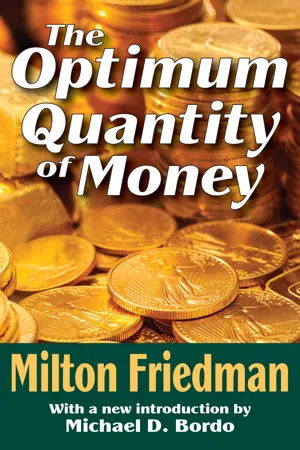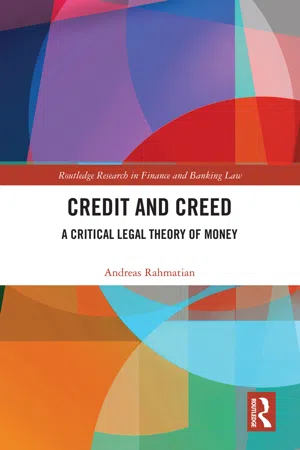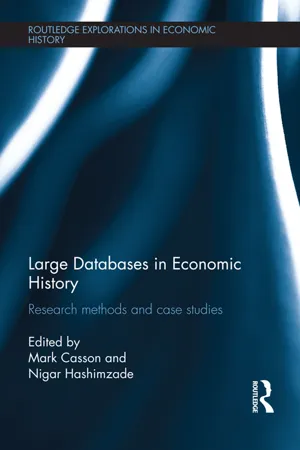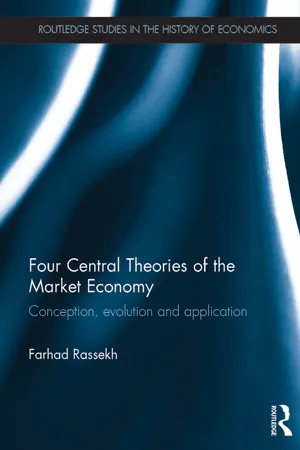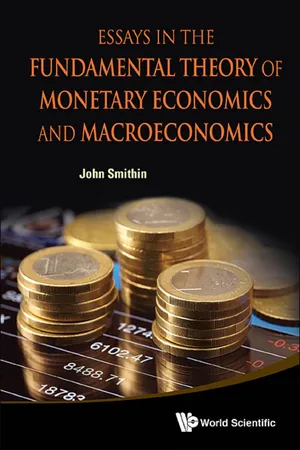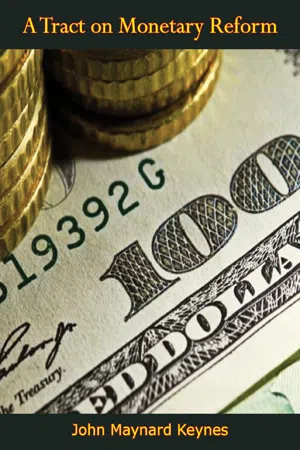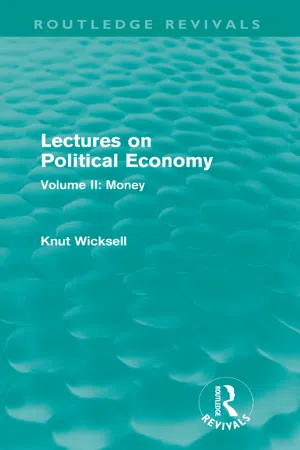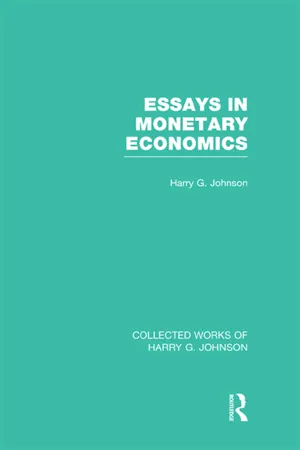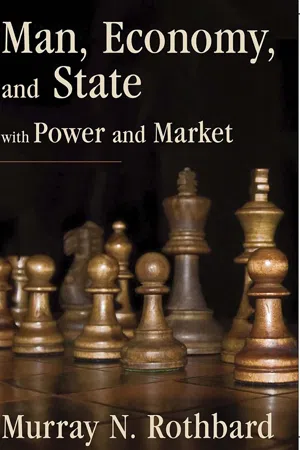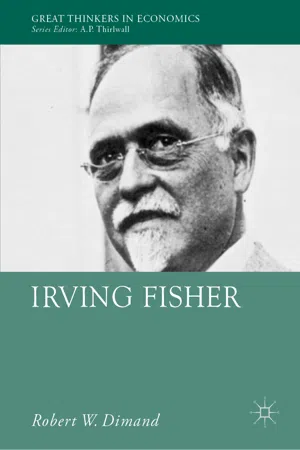Economics
Quantity Theory of Money
The Quantity Theory of Money is a theory that suggests a direct relationship between the supply of money in an economy and the price level of goods and services. It posits that changes in the money supply lead to proportional changes in the price level, assuming other factors remain constant. This theory is often used to analyze the impact of monetary policy on inflation.
Written by Perlego with AI-assistance
Related key terms
Related key terms
1 of 4
Related key terms
1 of 3
11 Key excerpts on "Quantity Theory of Money"
- eBook - ePub
- Milton Friedman(Author)
- 2017(Publication Date)
- Routledge(Publisher)
2The Quantity Theory of Money: A RestatementTHE QUANTITY THEORY of money is a term evocative of a general approach rather than a label for a well-defined theory. The exact content of the approach varies from a truism defining the term “velocity” to an allegedly rigid and unchanging ratio between the quantity of money—defined in one way or another—and the price level—also defined in one way or another. Whatever its precise meaning, it is clear that the general approach fell into disrepute after the crash of 1929 and the subsequent Great Depression and only recently has been slowly re-emerging into professional respectability.The present volume [Studies in the Quantity Theory of Money ] is partly a symptom of this re-emergence and partly a continuance of an aberrant tradition. Chicago was one of the few academic centers at which the quantity theory continued to be a central and vigorous part of the oral tradition throughout the 1930’s and 1940’s, where students continued to study monetary theory and to write theses on monetary problems. The quantity theory that retained this role differed sharply from the atrophied and rigid caricature that is so frequently described by the proponents of the new income-expenditure approach—and with some justice, to judge by much of the literature on policy that was spawned by quantity theorists. At Chicago, Henry Simons and Lloyd Mints directly, Frank Knight and Jacob Viner at one remove, taught and developed a more subtle and relevant version, one in which the quantity theory was connected and integrated with general price theory and became a flexible and sensitive tool for interpreting movements in aggregate economic activity and for developing relevant policy prescriptions.To the best of my knowledge, no systematic statement of this theory as developed at Chicago exists, though much can be read between the lines of Simons’ and Mints’s writings. And this is as it should be, for the Chicago tradition was not a rigid system, an unchangeable orthodoxy, but a way of looking at things. It was a theoretical approach that insisted that money does matter—that any interpretation of short-term movements in economic activity is likely to be seriously at fault if it neglects monetary changes and repercussions and if it leaves unexplained why people are willing to hold the particular nominal quantity of money in existence. - eBook - ePub
Credit and Creed
A Critical Legal Theory of Money
- Andreas Rahmatian(Author)
- 2019(Publication Date)
- Routledge(Publisher)
V ) if one seeks to examine the way in which money influences the price of (an aggregate of) individual transactions.131 Mankiw (2013: 93–94). The principal reason is that the newly created money has not (yet) left the banking system and is part of the reserves of the banks. The question whether it is ever supposed to do so, and if so, what the effects are, highlights one of the major points of criticism of the present monetary system, see Chapter 4, sec. 4.132 See Chapter 2.From the point of view of a legal theory of money, the Quantity Theory of Money is of almost no relevance. It cannot explain the legal qualities of money and its economic effects. But that has not been its purpose in the first place: the quantity theory seeks to demonstrate the relationship between quantity of money and price level and inflation – whether it is able to do that is left to economists to discuss.The reason why the classical Quantity Theory of Money has been considered here is because it is the basis of Friedman’s monetarism. Friedman’s theory as such is not particularly relevant to a legal theory of money either. However, it will be discussed now because the principal definitions of wealth in Friedman’s monetarism, and on the other hand the legal concepts of money and dematerialised property advanced here, have certain similarities, although my own conclusions are entirely different from Friedman’s.Friedman restates (and in effect qualifies) the classical Quantity Theory of Money: the quantity theory is a theory of the demand for money, not of output, or money income, or price level. It has the unusual characteristic of combining the supply of capital and the demand for capital. As with any other goods, the demand for money depends on (a) the total wealth to be held in various forms (equivalent of the budget restraint), (b) the price of and return on this and other forms of wealth, and (c) the tastes and preferences of the wealth-owning ‘units’ (i.e. customers as physical and legal persons).133 - eBook - ePub
- Frederick Lavington(Author)
- 2013(Publication Date)
- Routledge(Publisher)
PART II.—OUTLINE OF THE THEORY OF MONEYCHAPTER V
MONEY—THE QUANTITY THEORY
THE value of a unit of money, like the value of a unit of any other thing, is governed by influences operating through supply and demand, and is governed solely by influences operating through these channels. The exchange value of a yard of cloth tends to fall with every increase in the supply of that cloth and to rise with every increase in its demand; similarly, the exchange value of the piece of stamped bullion known as the sovereign tends to fall with any increase in the supply of sovereigns or their substitutes and to rise with any increase in demand; in neither case can exchange value be affected except through the channels of demand and supply.This is saying no more than that the general theory of value may be applied to explain the purchasing power of the sovereign in exactly the same way as it may be applied to explain the exchange value of everyday commodities, the rate of interest, or the level of wages. This general statement is not in dispute, but it is of some importance to lay emphasis upon it. For the theory of money contains certain minor peculiarities; and there is a tendency, if not actually to rest the theory on these peculiarities, at any rate to give them rather undue prominence, with the result that the theory comes to be regarded as a thing sui generis , distinct from, instead of a part of, the general theory of value.The first of these peculiarities lies in the fact that, with a careful definition of terms, it is possible not merely to say that a given change in demand or supply will cause the value of the sovereign to rise or fall, but to lay down a definite numerical relation between these two changes, e.g. - eBook - ePub
- Mark Casson, Nigar Hashimzade, Mark Casson, Nigar Hashimzade(Authors)
- 2013(Publication Date)
- Routledge(Publisher)
3 The Quantity Theory of Money in historical perspective Nick Mayhew 3.1 IntroductionThis paper uses the Quantity Theory of Money (QT) to analyse price variations in England, 1270–1750. Prices play an important role in economic history, as noted in Chapter 2 . The price level is a key influence on the cost of living. For a given level of money wages, the price level determines what baskets of ordinary products a wage-earner can afford to purchase. The price level is measured by taking a weighted average of commodity prices, using weights that correspond to the amount of each commodity contained in a representative basket of goods. Each price is measured in terms of money. A price index constructed in this way measures the rate of exchange between real goods on the one hand and a unit of currency on the other.The money price level measures the scarcity of goods relative to the scarcity of money. It is therefore influenced by both the amount of goods that sellers bring to market, and the amount of money that buyers bring with them with which to purchase the goods. Prices can rise either because goods are in short supply or because money is in abundant supply. This is one of the basic insights of the QT.The QT was developed in response to practical problems of stabilising prices through management of the currency. One of the pioneers of the QT was the seventeenth-century English philosopher, John Locke. The sixteenth century witnessed a major debasement of the English currency by Henry VIII, and the seventeenth century witnessed further volatility, due in part to the English Civil War. A systematic formulation of the QT was developed in the early twentieth century, when it was formulated independently by Irving Fisher in the US and by Cambridge economists (Alfred Marshall and his followers) in the UK. The theory was challenged by John Maynard Keynes in the 1930s because he believed that a very rigid application on QT principles contributed to the persistence of unemployment during the Great Depression. Keynes proposed a more flexible version of the theory, but in the 1970s the Chicago economist Milton Friedman was influential in asserting its validity in the long run. Recently, however, some of Friedman’s claims have been challenged on the grounds that the relationship between money and prices is not so stable as he asserted. - eBook - ePub
- Farhad Rassekh(Author)
- 2016(Publication Date)
- Routledge(Publisher)
Whatever may be the quantity of money in the country, only that part of it will affect prices, which goes into the market of commodities, and is there actually exchanged against goods. Whatever increases the amount of this portion of the money in the country, tends to raise prices. But money hoarded does not act on prices. Money kept in reserve by individuals to meet contingencies which do not occur, does not act on prices. The money in the coffers of the Bank, or retained as a reserve by private bankers, does not act on prices until drawn out, nor even then unless drawn out to be expended in commodities.Mill's expression of the quantity theory is as follows: “the quantity of money in circulation, is equal to the money value of all the goods sold, divided by the number which expresses the rapidity of circulation” (Ibid., p. 513).9 This is the equation of exchange that Ricardo had also expressed in words and, as we shall see in the next section, Alfred Marshall in 1871 translated into mathematics.Mill's analysis of the quantity theory in his Principles is reminiscent of his 1829 essay on Say's law in that he left for posterity a methodical and thorough description of a central theory in economics. Mill considered the quantity theory to be the foundation of monetary economics. He (Ibid., p. 514) wrote, “That an increase of the quantity of money raises prices, and a diminution lowers them, is the most elementary proposition in the theory of currency, and without it we should have no key to any of the others.”5 Alfred Marshall, Irving Fisher, and Knut Wicksell
In 1871, two years before Mill died, Alfred Marshall wrote an important piece on the quantity theory titled, “Essay on Money.”10 In this essay Marshall based his analysis of the quantity theory on Mill's theoretical framework in chapters VIII and IX of the Principles of Political Economy - John Smithin(Author)
- 2013(Publication Date)
- WSPC(Publisher)
etc.), Eq. (3.5) can also be written as:Still further simplifying the notation, we can let lower case p stand for the rate of inflation, as in previous chapter, also lower case m for the rate of growth of the money supply and lower case y for the economic growth rate. Therefore, Eqs. (3.5) and (3.6) are identical to:Each of Eqs. (3.4), (3.5) and (3.6) thus expresses the most basic insight of the quantity theory, which is that the inflation rate will be (roughly) equal to the rate of monetary growth less the economic growth rate. If the economic growth rate is 2.5% a year and money supply growth if 10%, then a quantity theorist would expect the inflation rate to be (about) 7.5%. To achieve zero inflation (stable money prices), money supply growth would have to be reduced to around 2.5%, to match the supply-determined economic growth rate. Nobody, presumably (even working with the very simplest version of the theory) would have expected these numbers to work out exactly in the real world, but this is the general idea.Potential Criticisms of the Quantity TheoryThe simplistic version of the quantity theory set out previously is potentially open to attack on three separate grounds, which correspond to each of the original assumptions made. First, the level of real income, Y , may indeed be affected by monetary factors, and therefore some of any change in the money supply may be reflected in a change in output, rather than prices. Second, the money supply, M, may not be a given quantity but could be an endogenous variable responsive to changes in other variables, via bank credit creation for example. Third, velocity, V , may not be a constant but also a variable, and in this case some (or all) of the effect of any money supply change might be absorbed in a change in velocity.In short, money may not be neutral, the money supply may be endogenous, and velocity may not be stable. Therefore, the caricature version of the quantity theory can hardly be regarded secure if it could be rebutted by even just mentioning any one of these points. Friedman’s attempt revive the quantity theory in the mid-1950s might well therefore have been understood in terms of an effort to meet each of these potential objections head on, thus generating a “more subtle and relevant” (Friedman, 1956, p. 3) version of the theory, which would be immune to these criticisms. For the monetarists, the idea that increases in money supply growth lead to inflation was- eBook - ePub
- John Maynard Keynes(Author)
- 2018(Publication Date)
- Papamoa Press(Publisher)
CHAPTER III—THE THEORY OF MONEY AND OF THE FOREIGN EXCHANGES
THE evil consequences of instability in the standard of value have now been sufficiently described. In this chapter{18} we must lay the theoretical foundations for the practical suggestions of the concluding chapters. Most academic treatises on monetary theory have been based, until lately, on so firm a presumption of a gold standard régime that they need to be adapted to the existing régime of mutually inconvertible paper standards.I. The Quantity Theory of Money
This Theory is fundamental. Its correspondence with fact is not open to question.{19} Nevertheless it is often misstated and misrepresented. Goschen’s saying of sixty years ago, that “there are many persons who cannot hear the relation of the level of prices to the volume of currency affirmed without a feeling akin to irritation,” still holds good.The Theory flows from the fact that money as such has no utility except what is derived from its exchange-value, that is to say from the utility of the things which it can buy. Valuable articles other than money have a utility in themselves. Provided that they are divisible and transferable, the total amount of this utility increases with their quantity;—it will not increase in full proportion to the quantity, but, up to the point of satiety, it does increase.If an article is used for money, such as gold, which has a utility in itself for other purposes, aside from its use as money, the strict statement of the theory, though fundamentally unchanged, is a little complicated. In present circumstances we can excuse ourselves this complication. A Currency Note has no utility in itself and is completely worthless except for the purchasing power which it has as money. - eBook - ePub
Lectures on Political Economy (Routledge Revivals)
Volume II: Money
- Knut Wicksell(Author)
- 2022(Publication Date)
- Routledge(Publisher)
B. Say, to regard goods themselves as reciprocally constituting and limiting the demand for each other. And indeed ultimately they do so; here, however, we are concerned with precisely what occurs, in the first place, with the middle link in the final exchange of one good against another, which is formed by the demand of money for goods and the supply of goods against money. Any theory of money worthy of the name must be able to show how and why the monetary or pecuniary demand for goods exceeds or falls short of the supply of goods in given conditions. The advocates of the Quantity Theory have perhaps not sufficiently considered this point. They usually make the mistake of postulating their assumptions instead of clearly proving them. That a large and a small quantity of money can serve the same purposes of turnover if commodity prices rise or fall proportionately to the quantity is one thing. It is another thing to show why such a change of price must always follow a change in the quantity of money and to describe what happens. Nor is this so easy, especially with our modern and extremely complicated monetary and credit systems. Nevertheless, in what follows we shall attempt to do so. In accordance with what has been said above we shall first describe the probable effects of a relative increase or decrease of the quantity of metallic money, and also the analogous phenomena associated with the issue of a State paper currency or inconvertible banknotes. We shall then consider in more detail the conditions of acceleration or retardation of the velocity of circulation and the influence of both on the value of money - Harry Johnson(Author)
- 2013(Publication Date)
- Routledge(Publisher)
1 It is possible to detect some redistribution among particular groups; but for this type of model to be proved useful for the analysis of inflation, it would be necessary to establish that the inflationary mechanism works by redistributing income among major income-receiving groups. This in turn would require that some of such groups be unable or unwilling to protect their real incomes from the impact of inflation; in fact, on the contrary, such protection is available to all groups in a freely competitive system, through negotiation of contracts to take account of expected inflation, and is increasingly resorted to as the fact of inflation is recognized. Consequently the Keynesian approach to inflation in terms of income redistribution seems less satisfactory than the alternative quantity theory approach to which I now turn, an approach which concentrates on the effects of inflation on wealth rather than on real income and its distribution.IV. THE QUANTITY THEORY APPROACH TO INFLATIONThe quantity theory approach to inflation differs essentially from that of the Keynesian models just discussed in the basic assumptions from which it starts: instead of assuming that wage changes provoke price changes and conversely through institutionally given (and therefore arbitrary) reaction coefficients it assumes that in an inflation the economy becomes accustomed to the expectation of continued inflation, so that the processes of determining wages and prices are fundamentally real processes and not arbitrary processes determined exogenously. The basic postulate of the quantity theory models of inflation is that there is a stable demand function for money in real terms, into which the rate of inflation enters as a cost of holding real balances, which cost influences the quantity of real balances held. Given this function, the rate of increase of the nominal stock of money determines the rate of inflation, the public eventually coming to expect that rate of inflation and adjusting its stock of real balances (or ratio of real balances to real income) to it. In order to maintain its real balances constant in the face of inflation, the public must accumulate money balances at a rate equal to the rate of inflation; this accumulation of money balances in order to preserve real balances is achieved at the cost of sacrificing the consumption of current real income in order to maintain real balances intact, the release of current real income constituting the equivalent of a ‘tax’ on the holders of real balances; the tax on real balances, in turn, accrues as revenue to the beneficiaries of the inflationary increase in the money supply.1- eBook - ePub
- Murray N(Author)
- 2014(Publication Date)
- Editorial Bubok Publishing(Publisher)
11MONEY AND ITS PURCHASING POWER1. IntroductionMONEY HAS ENTERED INTO ALMOST all our discussion so far. In chapter 3 we saw how the economy evolved from barter to indirect exchange. We saw the patterns of indirect exchange and the types of allocations of income and expenditure that are made in a monetary economy. In chapter 4 we discussed money prices and their formation, analyzed the marginal utility of money, and demonstrated how monetary theory can be subsumed under utility theory by means of the money regression theorem. In chapter 6 we saw how monetary calculation in markets is essential to a complex, developed economy, and we analyzed the structure of post-income and pre-income demands for and supplies of money on the time market. And from chapter 2 on, all our discussion has dealt with a monetary-exchange economy.The time has come to draw the threads of our analysis of the market together by completing our study of money and of the effects of changes in monetary relations on the economic system. In this chapter we shall continue to conduct the analysis within the framework of the free-market economy.2. The Money Relation: The Demand for and the Supply of MoneyMoney is a commodity that serves as a general medium of exchange; its exchanges therefore permeate the economic system. Like all commodities, it has a market demand and a market supply, although its special situation lends it many unique features. We saw in chapter 4 that its “price” has no unique expression on the market. Other commodities are all expressible in terms of units of money and therefore have uniquely identifiable prices. The money commodity, however, can be expressed only by an array of all the other commodities, i.e., all the goods and services that money can buy on the market. This array has no uniquely expressible unit, and, as we shall see, changes in the array cannot be measured. Yet the concept of the “price” or the “value” of money, or the “purchasing power of the monetary unit,” is no less real and important for all that. It simply must be borne in mind that, as we saw in chapter 4 - eBook - ePub
- Robert W. Dimand(Author)
- 2019(Publication Date)
- Palgrave Macmillan(Publisher)
clearly how Laughlin and Laughlin’s University of Chicago graduate students Sarah McLean Hardy 7 (1895 ), Wesley C. Mitchell (1896 ), and H. Parker Willis (1896 ) had gone astray in their attempts at statistical refutation of the Quantity Theory of Money . Laughlin and his students had argued that the price level P had not moved in step with the money supply M in the United States since the Civil War—but they had not allowed for the upward trend of T , which would increase the demand for real money balances. Fisher’s attempt to persuade Laughlin of the error of his ways was not well received (see Laughlin 1911 , Fisher 1911a ), and the Journal of Political Economy , edited by Laughlin , was unusual among economics journal in not reviewing The Purchasing Powerof Money(see reviews reprinted in Dimand 2007 , Vol. 2).Fisher and the Velocity of Circulation
Fisher also needed to respond to the widespread view that the equation of exchange was not a useful framework for organizing empirical research, but only a tautology that defined the velocity of circulation V as PT /M . Indeed, his expanded equation of exchange , separating currency M and bank deposits M ′, would not even suffice to define the two velocities V and V ′. Accordingly, Fisher attempted to obtain measures of the two velocities distinct from the equation of exchange . He insisted that, except for transition periods, changes in the velocity of circulation reflected such influences as improvements in payment systems and were independent of changes in the quantities of currency and deposits, the price level and the volume of trade. To measure V , Fisher persuaded Yale undergraduates to keep track of their currency holdings and spending, reporting that “A hundred such returns among students at Yale University indicate an average velocity of forty-five times a year, making the average length of time a dollar rests in one man’s hands about eight days” (Fisher 1897 , p. 520). Fisher (with Brown 1911a
Index pages curate the most relevant extracts from our library of academic textbooks. They’ve been created using an in-house natural language model (NLM), each adding context and meaning to key research topics.
Explore more topic indexes
Explore more topic indexes
1 of 6
Explore more topic indexes
1 of 4
